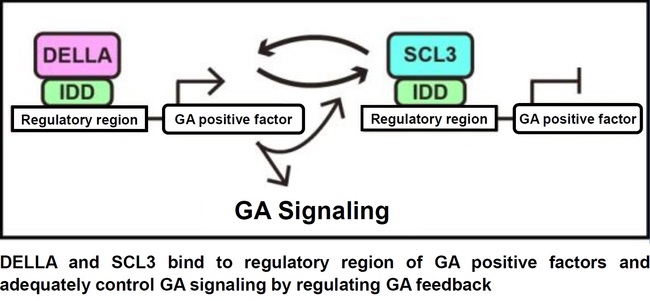 A research team led by Dr. Miyako Ueguchi, Associate Professor, and Mr. Hideki Yoshida, a first-year PhD student at the Bioscience and Biotechnology Center, Nagoya University, has discovered the mechanism underlying the regulation of gibberellin (GA) signaling that controls the growth of plants. Their paper was published online in PNAS on May 12, 2014.
A research team led by Dr. Miyako Ueguchi, Associate Professor, and Mr. Hideki Yoshida, a first-year PhD student at the Bioscience and Biotechnology Center, Nagoya University, has discovered the mechanism underlying the regulation of gibberellin (GA) signaling that controls the growth of plants. Their paper was published online in PNAS on May 12, 2014.
GA is a plant hormone involved in many physiological phenomena, such as flowering, elongation of leaves and stem, and fruit enlargement. When GA increases, the stems of plants become elongated; when GA decreases, they become shorter. Previous research has elucidated that DELLA, a key negative regulator of GA, increases the gene expression of GA positive factors that work in GA feedback regulation, by binding with the regulatory region of the factors via some sort of mediator. However, the mediator has not been identified, and the regulatory mechanism has not been explained.
Prof. Ueguchi's research group took up the challenge to identify the mediator and examined binding between DELLA, the regulatory region of the GA positive factors, and more than 1,500 types of proteins. As a result, they identified that five members of the INDETERMINATE DOMAIN (IDD) protein family mediate the interaction between DELLA and the regulatory region. Moreover, they discovered that when GA decreases too much, DELLA binds to the regulatory region via IDD and increases GA positive factors, such as SCL3 proteins, receptors, and GA biosynthetic enzymes. When GA increases too much due to the abundance of GA positive factors, SCL3 proteins in turn bind to the regulatory region via IDD and decrease the gene expression of GA positive factors. In this way, DELLA and SCL3 fine-tune the promotion and regulation of GA signaling and create an overall balance in plant growth. This is the first discovery of a coordination mechanism in plants, although such mechanisms in animals have previously been reported. If this mechanism can be artificially controlled, we can potentially manipulate growth of crops. This is widely expected to contribute to the enhancement of production of useful plants and the promotion research on signaling in plants.
Associate Professor Miyako Ueguchi-Tanaka
Associate Professor Miyako Ueguchi has had an interest in natural science since childhood, and being a researcher was her dream. As a child, she observed pollen, scales, and plankton through a microscope and conducted experiments with plants in a closet with a dark-room environment. She finds it appealing to conduct research in which she proposes a hypothesis, identifies factors that prove the hypothesis, and links knowledge. She currently conducts research at the Bioscience and Biotechnology Center, Nagoya University, to reveal the entire mechanism underlying gibberellin signaling.
Outlook for the Future
"Gibberellin is a plant hormone that is important for plant growth. I have long been researching how it is received in plant cells. I would like to focus on phenomena involving GA by which plants increase in length and aim to understand how GA is involved in plant and cell elongation. I believe my research will contribute to enhancing knowledge regarding "biomass production by plants," which will be increasingly important in the future."
Message to Young Students
 "If you discover your interest, whatever it is, please examine and experiment. If you want to be a researcher, please try without hesitation. I find that it is worth everything that I explore the mechanisms underlying the inner phenomena of plants and prove my hypothesis through experimentation. Much of the time spent in research is tough and severe, but I can continue my research to enjoy such moments."
"If you discover your interest, whatever it is, please examine and experiment. If you want to be a researcher, please try without hesitation. I find that it is worth everything that I explore the mechanisms underlying the inner phenomena of plants and prove my hypothesis through experimentation. Much of the time spent in research is tough and severe, but I can continue my research to enjoy such moments."
Links
Research Information
Nagoya University Press Release (Japanese)
PNAS
Associate Professor Miyako Ueguchi Information
Nagoya University Faculty Member Profile
Bioscience and Biotechnology Center